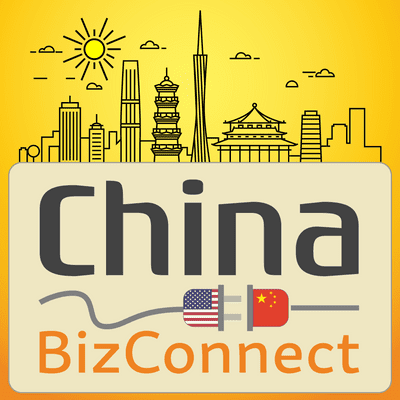
China BizConnect
Podcast af China BizConnect
China BizConnect explores the fast-changing landscape of business-to-business (b2b) sales and marketing in China. We strive to provide leaders of tech companies with strategies to succeed in China’s b2b technology market. We also try to help you avoid many of the traps along the way. Hosts Tim Lindeman and Michael Bragen interview China tech industry experts and experienced business leaders who have entered the China market.
Begrænset tilbud
2 måneder kun 1,00 kr.
Derefter 99,00 kr. / månedIngen binding.
Alle episoder
14 episoderCONSIDERATIONS FOR FOREIGN VENDORS FACING GROWING COMPETITION AND PROTECTIONISM By Tim Lindeman [https://www.linkedin.com/in/timlindeman/] SELLING TECHNOLOGY TO THE CHINESE GOVERNMENT [HTTPS://CHINABIZCONNECT.COM/WP-CONTENT/UPLOADS/2020/03/SELLING-TECHNOLOGY-TO-THE-CHINESE-GOVERNMENT@4X-1024X536.PNG] LISTEN TO THE PODCAST About Guest: Nicole Guo is Business Development Manager for Alicloud [http://www.alibabacloud.com] responsible for government sales in the Guangdong province. Nicole focuses on smart city projects to help the government automate its services and workflows. Prior to working for Alibaba, Nicole worked for Dimensional Insight [http://www.dimins.com] in China marketing data and analytics services to Chinese hospitals. SUMMARY Selling technology to any foreign government can be challenging due to national security concerns and a bias to support the local industry. This is especially the case in China, where heightened international tensions and protectionist policies in the West have caused China to look for ways to reduce its reliance on foreign technology. Despite these challenges, the Chinese government remains an attractive target for many foreign technology vendors, because it is a major technology consumer that relies on foreign suppliers to meet many of its needs. This article explores key challenges foreign tech vendors face when selling to the Chinese government. And for companies up to the challenge, it investigates important considerations and tactics for succeeding in government sales. TAKEAWAYS The window of opportunity for foreign vendors is closing While there are still technology categories where foreign products have a strong competitive advantage, the government is increasing support for domestic firms to close the gap. Planning and procurement processes make selling complicated A sophisticated planning cycle influences technology purchases at all levels of the government. And foreign vendors have a hard time navigating the government’s complicated procurement process. Relationships remain important despite the crackdown on corruption The anti-corruption campaign has changed the way that vendors interact with the government. Vendors must learn new ways to build relationships, so they can build trust and win favor. AN UNLEVEL PLAYING FIELD In recent years, many in the West have criticized China’s “unfair” trade practices. And although fairness is difficult to judge, it is clear that many foreign technology firms struggle in China’s “socialist market economy.” Some point the finger at China’s central planning. They claim that the government’s interference in the market creates a home-field advantage for domestic firms. To illustrate this point, the government’s Made in China 2025 initiative aims to upgrade China’s manufacturing capabilities by subsidizing domestic innovation and targeting 70% “self-sufficiency” in high-tech components. (see endnote 1) Foreign opposition has been so loud that China has largely suspended media promotion of this initiative. (see endnote 2) However, it is unlikely that the government has given up on the policy’s core objectives. Another example relates specifically to government technology purchases. According to the Financial Times, China issued a directive to replace all foreign hardware and software used in the government and the public sector with domestic technology by the end of 2022. (see endnote 3) However, no other media outlet has been able to provide independent confirmation of this directive. And experts from major analyst firms see little evidence that such a policy exists. Furthermore, analysts suggest that the reported aims are not achievable given current gaps in the maturity of Chinese technology. Regardless of whether there is a formal policy in place, the Chinese government is clearly working to support domestic vendors and reduce reliance on foreign technology. And government procurement of domestic technology is a powerful tool to support the development of the local industry. In addition to the government’s favoritism towards domestic firms, foreign tech vendors selling in this space have other significant hurdles. Finding opportunities to sell requires deep local relationships. The procurement process is complex and highly regulated. And if successful, managing government projects is very difficult and getting paid for the work is also challenging. DOES TARGETING THE CHINESE GOVERNMENT MAKE SENSE? Given the unlevel playing field, does it even make sense for foreign tech firms to target the Chinese government and public sector? This is a complicated question. And the answer is different for each company. But one thing is certain, the size of China’s government IT budget is huge and is growing rapidly. (see endnote 4) The following key considerations should help you decide if this market segment is appropriate for your company. CONSIDERATION 1 – AVAILABILITY OF CHINESE SUBSTITUTES While the government would like to use domestic technologies wherever possible, there are still gaps where suitable local technologies are not available. In such cases, the government relies on foreign technologies to meet its needs. In general, China is relatively strong in emerging technologies. The main reason for this is it takes many years of development to recreate mature technologies. Therefore, the government has identified strategic areas to invest in, such as cloud, artificial intelligence, internet of things, 5G, and blockchain. By investing in these areas, China has the opportunity to get ahead. Furthermore, some of these emerging technologies have the capacity to leapfrog mature technologies by offering similar functionality using an entirely new platform. (see endnote 5) China is also relatively strong in applied technologies. In contrast to foundational technologies, which require specialized knowledge and significant R&D investment, applied technologies rely more on quick market execution. Chinese technology companies excel in this area because they are willing to work long hours and have a better understanding of local requirements. They are able to produce a wide variety of workflow systems and specialized applications and get them to market very fast. Foreign technologies, on the other hand, have relatively few substitutes in the foundational and mature technology spaces. Some examples of such technologies include computer processors, operating systems, engineering and design software, database management systems, and application development frameworks. (see endnote 6) Foreign technologies are also strong in high-end emerging technology and application spaces. In these areas, foreign companies benefit from access to expert talent and have accumulated years of development in sophisticated applications. FIGURE 1: FOREIGN VS. DOMESTIC TECHNOLOGY IN THE CHINESE MARKET Foreign vs. Chinese Technology [https://chinabizconnect.com/wp-content/uploads/2020/03/Figure1-Foreign_vs_Chinese_Technology-1024x770.png] [https://chinabizconnect.com/figure1-foreign_vs_chinese_technology-3/] The matrix in Figure 1 provides a high-level guide to determining if a particular technology is likely to have substitutes in the Chinese market. Regardless of where your technology sits in the matrix, you should perform market research to uncover and evaluate competing domestic products. If you have strong domestic competitors and are still interested in going after the market, you should consider ways to make your product less “foreign.” (see consideration 3 below) CONSIDERATION 2 – TARGET SEGMENT WITHIN THE GOVERNMENT MARKET Since the Chinese government is large and complex it is good to break the market into segments. (see Figure 2) At the top is the central government with its many branches. And underneath is a myriad of agencies at the regional and local levels. In addition to the core government, there is a secondary market that includes the government-controlled public sector and state-owned enterprises (SOEs). Given its massive size and the limited availability of domestic technologies, the government will likely take a staged approach in reducing reliance on foreign technology. It will take years for domestic vendors to offer competitive substitutes for all the government’s technology needs. And during that time, foreign vendors will have a sizable window of opportunity to sell to segments with lower priorities for domestic adoption. The core government segment is the highest priority. Sensitive agencies such as the military and other groups related to national security are already early adopters of Chinese tech. They often pay high prices for fledgling technologies in order to support the development of domestic products. State-owned enterprises in industries like banking, insurance, telecommunications, and media are the second priority. And the public sector, which includes schools, universities, hospitals, research institutes, and cultural organizations, are a much lower priority. FIGURE 2: GOVERNMENT PRIORITIES FOR REPLACEMENT OF FOREIGN TECHNOLOGY Government Priorities for Tech Replacement [https://chinabizconnect.com/wp-content/uploads/2020/03/Figure2-Government-Priorities-for-Tech-Replacement-1024x678.png] [https://chinabizconnect.com/figure2-government-priorities-for-tech-replacement-3/] CONSIDERATION 3 – HOW “FOREIGN” YOUR PRODUCT IS In the globalized world, it is really hard to pinpoint a given product’s country of origin. This is especially the case for complex products with numerous outsourced parts. Computer hardware is a good example. Lenovo may be a Chinese company, but it uses a foreign-acquired trademark (ThinkPad) and its products are filled with foreign parts. Even Huawei, which is arguably China’s leading technology innovator, still depends on many foreign hardware and software components for its products. Two of the most important factors that make a product “Chinese” are branding and sales. Foreign technology companies can acquire a Chinese brand and sales force by partnering with local application vendors, system integrators, and resellers. Such partners frequently bundle foreign technology into complex solutions or build entirely new products on top of foreign foundational technology. In the minds of many Chinese buyers, these products are essentially Chinese. For foreign companies selling end-to-end solutions, stand-alone tools, business applications, or services, the challenge is more difficult. As China favors the acquisition of domestic tech, it will be increasingly important for foreign vendors to invest in local research and development to dilute their technology’s foreign origin. In some cases, especially when targeting sensitive market segments, forming a joint venture with a Chinese company can be the most effective approach. Another important strategy is to support compatibility with Chinese hardware and cloud services. Foreign technologies that do this will continue to function well as more Chinese technologies dominate the ecosystem. Chinese government agencies will also consider such technologies to be more secure. CENTRAL PLANNING AND INFLUENCE Central planning is a key feature of China’s “socialist market economy.” The government’s plans influence the direction of technological development for the entire country and have a significant impact on government technology procurement. While it is generally important for all technology firms to pay attention to these plans, it is particularly important for vendors who sell to the government. The government’s five-year planning cycle provides a framework for planning at all levels of the government and covers many key areas of China’s society and economy. The planning process is continuous and dynamic. It covers all stages of planning, from analysis and policy creation to implementation and monitoring. (see endnote 7) Some important planning milestones include: * Five Year Plan: general growth targets and milestones across a broad range of topics related to China’s social and economic development. * Issue-based plans and sub-plans: hundreds of more detailed documents about each objective in the Five Year Plan. * Implementation notices and measures: programs from government departments at all levels spelling out specific instructions for achieving the various targets and milestones. (see endnote 8) FIGURE 3: THE CHINESE GOVERNMENT’S FIVE YEAR PLANNING CYCLE The Chinese Government’s Five Year Planning Cycle [https://chinabizconnect.com/wp-content/uploads/2020/03/Figure3-Five-Year-Planning-Cycle-1024x679.png] [https://chinabizconnect.com/figure3-five-year-planning-cycle-3/] For any particular industrial sector or technology area, the relevant information is spread across a variety of plans at the national, provincial, and local levels. Figure 4 provides an example of a large number of documents that are relevant to one particular industry. (see endnote 9) FIGURE 4: EXAMPLE OF RELEVANT CHINESE GOVERNMENT PLANS IN SPECIFIC INDUSTRY Example of Relevant Chinese Government Plans in Specific Industry [https://chinabizconnect.com/wp-content/uploads/2020/03/Figure4-Example-of-Relevant-Plans-in-Specific-Industry-1024x964.png] [https://chinabizconnect.com/figure4-example-of-relevant-plans-in-specific-industry-2/] It is important for technology vendors operating in China to follow the major planning milestones, pay attention to relevant plans and sub-plans, and stay current on the latest policy changes. While this is not an easy task, understanding the direction the government is going is essential for identifying opportunities where a particular technology can help the government to achieve its aims. Fortunately, industry-focused institutes and associations in China can provide excellent resources to help technology vendors in a particular industry keep abreast of the government’s priorities. (see endnote 10) FROM PLANS TO OPPORTUNITIES After gaining an understanding of the goals in a particular area, you can begin to have conversations and work to create a vision for how your products or services can help the government obtain these goals. First, identify an initial government agency or government-controlled organization to target. Before visiting the office, find out as much as possible about their particular business by reading published reports and related plans. Prepare custom talking points that address specific goals and provide examples of how you have helped other clients solve similar problems. It is crucial to speak the same language of your target audience and understand the issues that are most important to them. If they are interested in what you share, they may give you a chance to brainstorm opportunities to work together to achieve their goals. Since government procurement typically involves multiple leaders, you should look for opportunities to speak with both business and technology departments. If possible, get an introduction through your professional network. Otherwise, approach the office directly. It can take time to work your way up the org chart, but if you have a strong message this approach will also work. (see endnote 11) Another option is to work with a Chinese partner. Look for a firm that sells complementary technologies and has a good reputation in the government market. An effective partner can make introductions, take on responsibility for selling, or even deliver the technology independently. In more sensitive government sectors, being able to sell your services under the umbrella of a Chinese company is an excellent way to reduce bias against your product being foreign. FROM BUDGETS TO PUBLIC TENDERS Once you find a suitable project to help a government agency or government-controlled organization to obtain its goals, the next step is to get a budget for the project. If the project is small, it may be possible to use an existing budget. Otherwise, the purchasing office will likely need to pursue funding during the annual budgeting process. The budgeting process is different depending on whether the purchasing office belongs to the government, a state-owned enterprise, or a public-sector organization. For government offices, the process begins at the end of each year. Each office drafts a budget then submits it to higher-level government offices for review, revision, and inclusion in the national budget. Finally, the National People’s Conference approves the budget at its annual meeting in March. (see endnote 12) FIGURE 5: THE CHINESE GOVERNMENT’S BUDGETING PROCESS The Chinese Government's Budgeting Process [https://chinabizconnect.com/wp-content/uploads/2020/03/Figure5-Chinese-Government-Budgeting-Process-1024x644.png] [https://chinabizconnect.com/figure5-chinese-government-budgeting-process-3/] After obtaining a budget, the government office must spend the funds before the end of the year. Otherwise, they will need to reapply for a budget for the following year. The process for purchasing technology is formal and complex. Government offices and government-funded public sector organizations typically use public tenders for large technology projects. They first create a request for proposal (RFP) document outlining the project requirements and criteria for vendor selection. (see endnote 13) And then they collaborate with a purchasing center to publicly solicit bids, organize a panel of experts to evaluate vendor submissions, and select the winning bidder. (see endnotes 14 and 15) FIGURE 6: CHINA’S PUBLIC PROCUREMENT PROCESS China's Public Procurement Process [https://chinabizconnect.com/wp-content/uploads/2020/03/Figure6-Public-Procurement-Process-in-China-1024x653.png] [https://chinabizconnect.com/figure6-public-procurement-process-in-china-3/] Although the process is transparent, the purchasing office can still influence the tender in favor of a particular vendor. A common way to do this is to include very specific selection criteria. Some examples include requiring the vendor to have a local branch, minimum registered capital, a certain number of employees, and domestically-sourced technical components. Additionally, some categories of procurement are only open to companies on an approved vendor list. (see endnote 16) Vendors also have opportunities to influence the process. For example, they can share RFP templates including specific requirements for functionality that are unique to their product with the purchasing office. Another common practice is to collude with other businesses to submit competing bids. (see endnote 17) Naturally, the friendly competitors submit tenders designed to ultimately lose. In the past, unless a vendor got involved very early in the purchasing process, there was little chance to win a deal. In recent years the government has made big strides to make the process fairer. One way they have done this is by investing in information systems that track procurement details and make it easier to identify purchasing fraud. Now it is possible for vendors to compete for projects where they have no existing relationship with the customer and have a reasonable chance of winning. There are a number of information services in China that collect data on public tenders. (see endnote 18) Vendors who subscribe to these services can set up alerts to notify them immediately when a new tender is published that matches their search criteria. This way, vendors have adequate time to contact the relevant purchasing center, acquire the bidding documents, and participate in the tender. These information services also provide valuable market intelligence. Not only do they include information about the purchaser, project, and selected vendor, they also list the price of the winning bid. Vendors can use this information to understand the size of the market, the areas of opportunity, and the competitive landscape. RELATIONSHIPS AND CORRUPTION Although China has made significant progress in making government procurement more transparent and impartial, relationships are still very important. Traditionally, vendors relied on social interactions outside of work to build relationships with government officials. This involved fancy meals, alcohol, and entertainment. And all too often, when these interactions were not enough, vendors used bribery to bridge the gap. (see endnote 19) Much of this changed in 2013 when Xi Jinping began a sweeping campaign to crush corruption. Xi targeted individuals in high and low positions, arresting 100,000 government officials and businesspeople and removing even more from their posts. (see endnote 20) This had a significant impact on technology vendors, forcing them to start over and build new relationships without traditional tools. On the surface, the crackdown on corruption has brought about considerable change. Government officials are now much less willing to have dinners or accept gifts from companies. But under the surface, businesses have found more discreet ways to obtain favor. (see endnote 21) And there are recent signs that the campaign is winding down. (see endnotes 22 and 23) FIGURE 7: CHINA’S ANTI-CORRUPTION CASES VS. CORRUPTION PERCEPTION China's Anti-Corruption Cases vs. Corruption Perception [https://chinabizconnect.com/wp-content/uploads/2020/03/Figure7-Anti-Corruption-Cases-vs-Corruption-Perception-1024x563.png] [https://chinabizconnect.com/figure7-anti-corruption-cases-vs-corruption-perception-3/] Regardless of how effective Xi Jinping’s crackdown on corruption has been, it has led to significant changes in purchasing behavior. (see endnote 24) And these changes are especially challenging for foreign vendors because they often lack the cultural nuance needed to adapt quickly. One way to manage this weakness is to give Chinese partners more responsibility for developing relationships with the government. However, this approach has the disadvantage of reducing the exposure to end customers and control over the selling process. Another approach is to increase investment in pre-sales activities that demonstrate business value, such as proof of concepts. (see endnote 25) By doing this, vendor staff will have more opportunities to build working relationships with individuals in the government and prove the advantages of their solutions. RECOMMENDATIONS SET A HIGH BAR BEFORE TARGETING THE GOVERNMENT MARKET Before choosing the government as a target market, make sure your product has a sustainable competitive advantage. Consider the government’s priorities for domestic technology development and determine if your category is at risk. Also evaluate adjacent markets, such as state-owned enterprises and the public sector, that may be a lower priority for domestic technology replacement. USE KNOWLEDGE OF GOVERNMENT PLANS TO CREATE VALUE PROPOSITIONS Every branch of the government is focused on obtaining goals set in the Five Year Plan and related planning documents. Become knowledgeable of all of the plans concerning your technology and the government segment you are selling to. Use this knowledge to create value propositions showing how your product can help the government obtain its goals. CONSIDER PARTNERING WITH LOCAL COMPANIES TO INCREASE ODDS OF SUCCESS Given the preference for local vendors, consider working with Chinese partners to embed, rebrand, and fully localize your product for the Chinese market. With complex technologies, few products are 100% Chinese. By working with local partners, you can make your offering more “Chinese” and benefit from your partners’ relationships and experience handling the government’s complex procurement process. SUGGESTED READING Why Foreign Tech Vendors Should Carefully Consider the China Market [https://chinabizconnect.com/why-foreign-tech-vendors-should-carefully-consider-china/] Case Study: Analytics Software Company Goes It Alone In China [https://chinabizconnect.com/an-analytics-software-company-goes-it-alone-in-china/] A Disciplined Approach to China Market Entry [https://chinabizconnect.com/disciplined-approach-to-china-market-entry/] ENDNOTES 1. Source: “Why Does Everyone Hate Made in China 2025?” Council on Foreign Relations, March 28, 2018 (https://www.cfr.org/blog/why-does-everyone-hate-made-china-2025) Back to text 2. Source “’Made in China 2025′ Unmade?” Macropolo, August 20, 2019 (https://macropolo.org/analysis/made-in-china-2025-dropped-media-analysis/) Back to text 3. Source: “Beijing orders state offices to replace foreign PCs and software,” Financial Times, December 8, 2019 (https://www.ft.com/content/b55fc6ee-1787-11ea-8d73-6303645ac406) Back to text 4. Using the Beijing city government as a benchmark, IT expenses accounted for approximately 1% of total government expenses in 2019. This percentage applied to the projected 2020 national budget of nearly 26 trillion RMB ($3.7 trillion USD) is about $37 billion USD. Source: “Beijing Shi 2019 Nian Yusuan Zhixing Qingkuang he 2020 Nian Yusuan,” Beijing City Finance Department, January 2020 (http://czj.beijing.gov.cn/zwxx/czsj/czyjs/202002/P020200204437920220330.pdf) Back to text 5. One good example of the leapfrog effect is the cloud replacing traditional desktop operating systems and client applications. Services such as Alibaba Cloud have emerged as an alternate “network operating system” and offer a rich marketplace filled with Chinese-made cloud applications and services. Back to text 6. China has identified 35 critical technology areas where it relies almost exclusively on foreign producers. Source: “Ka Zhongguo Bozi De 35 Xiang Jishu,” Eeworld, December 14, 2019 (http://news.eeworld.com.cn/mp/s/a78050.jspx) Back to text 7. Source: “China’s Five-Year Planning System: Implications for the Reform Agenda,” Oliver Melton, April 22, 2015 (https://www.uscc.gov/sites/default/files/Melton%20-%20Written%20Testimony.pdf) Back to text 8. Source: “An Intro to China’s Policymaking Process,” Trivium, viewed on January 17, 2020 (https://triviumchina.com/2018/09/03/an-intro-to-chinas-policymaking-process/) Back to text 9. Source: “Overview of China`s Five-Year Plans in the Transport Sector,” GIZ China, December 1, 2017 (http://www.sustainabletransport.org/wp-content/uploads/2017/12/20171201_GIZ-Chinas-Five-Year-Plans-in-the-Transport.pdf) Back to text 10. There are many different sources to collect information about Chinese government planning. Each government department has its own website and makes plans available for the public. The Ministry of Information Industry and Statistics Bureau also provide valuable reports. Back to text 11. Source: “Xiaoshou Xinshou Ruhe Dakai Zhengfu de Da Men,” Renhe Wang, viewed on February 6, 2020 (http://www.renhe.cn/answers/44770) Back to text 12. Source: “Difang Caizheng Yusuan Guanli Liucheng,” Licun Chen, Baidu Wenku, September 19, 2019 (https://wenku.baidu.com/view/64edbaaf2a160b4e767f5acfa1c7aa00b42a9dc4.html) Back to text 13. The winning bidder is usually selected based on a weighted set of criteria that includes price, technology capabilities, and other business requirements. Back to text 14. Source: “Public Procurement in China: overview,” Thomson Reuters Practical Law, November 1, 2013 (https://content.next.westlaw.com/Document/I2ef129701ed511e38578f7ccc38dcbee/View/FullText.html) Back to text 15. Source: “Zhengfude Caigou Liucheng Shi Zenyangde,” Baidu Jingyan, June 6, 2009 (https://jingyan.baidu.com/article/cb5d6105b4056e005c2fe0c8.html) Back to text 16. For some categories of technology, the government keeps a list of approved vendors. The requirements for getting included in this list vary. Back to text 17. Public tenders usually require a minimum of three qualifying bids. In cases where there are not enough competing bids, some vendors will solicit inferior bids from friendly businesses. As procurement systems improve, the government is collecting more information about “fake” bids and getting better at identifying tender fraud. Back to text 18. One such information source is Qianlima Zhaobiao Wang: http://www.qianlima.com/ Back to text 19. It is important to note that not all Chinese leaders in this time period were corrupt. And even those who accepted bribes often made responsible purchasing decisions. The money spent on building relationships was a basic cost of doing business. However, there were also many cases where greedy or miscalculating government officials and business leaders spent far too much money on “greasing the wheels.” And in order to complete their projects with the limited funds left over, they made disastrous compromises on quality and safety. Back to text 20. Source: “It’s no wonder China’s Xi Jinping is winding down anti-corruption efforts – they’ve barely made a dent,” The Independent, January 29, 2019 (https://www.independent.co.uk/voices/xi-jinping-china-corruption-scandal-new-figures-a8751206.html) Back to text 21. Government officials are generally much more cautious about receiving benefits from businesses then they were in the past. Before, careful officials would distance themselves from direct exchanges of benefit by encouraging interactions with trusted family members. Now, such officials are distancing themselves even further and are becoming more creative about the third parties involved. Also, some insiders have shared with us that instead of inviting government officials to luxurious venues, businesses are now using “underground” venues that look like shacks on the outside but employ 5-star chefs and have an abundant supply of Maotai. Back to text 22. Source: “China’s False War on Corruption,” The Walrus, January 10, 2020 (https://thewalrus.ca/corruption-chinas-false-war-on-corruption/) Back to text 23. Source: “Visualizing China’s Anti-Corruption Campaign,” ChinaFile, August 15, 2018 (https://www.chinafile.com/infographics/visualizing-chinas-anti-corruption-campaign) Back to text 24. Source: “Corruption Perceptions Index 2019,” Transparency International, viewed on March 17, 2020 (https://www.transparency.org/cpi2019) Back to text 25. Proof of concepts (PoCs) are an approach that technology companies use during pre-sales. The vendor will typically work with the customer to select a quick project that offers clear benefits and implement the project for little or no money. By doing this, the vendor has the opportunity of building a relationship and gaining vendor commitment for its product. Often the costs of performing a PoC are significantly less than entertaining potential clients. Back to text If you are interested in having a conversation about whether or not it makes sense for your company to sell technology to the Chinese government or other China business-related topics, please connect with me on LinkedIn [https://www.linkedin.com/in/timlindeman/]. Stay current with China BizConnect’s latest articles by subscribing to our newsletter [https://chinabizconnect.com/subscribe-to-the-china-bizconnect-newsletter/].
A SYSTEMATIC APPROACH By Tim Lindeman [https://www.linkedin.com/in/timlindeman/] WHERE TO LAND YOUR TECH COMPANY IN CHINA [HTTPS://CHINABIZCONNECT.COM/WP-CONTENT/UPLOADS/2019/12/E013-CHOOSING-THE-BEST-CITY-IN-CHINA-FOR-YOUR-TECH-COMPANY-BANNER@2X-1024X536.PNG] LISTEN TO THE PODCAST About Guests: Xiaoling Wu [https://www.linkedin.com/in/xiaoling-wu-2bb32945/] is Head Representative and Jin Hu [https://www.linkedin.com/in/jin-hu-17989b160/] is Director of Programming at the Guangzhou Liaison Office in Boston [https://www.gzlob.org/]. The municipal government of Guangzhou established this office to foster an abiding, bilateral exchange of people, ideas, and capital, with the goal of forging strategic partnerships with organizations in the United States. SUMMARY The choice of where to land in China will have a huge impact on your business. But too often companies make this decision in an ad hoc manner. This article outlines a systematic approach to identify and evaluate Chinese cities based on your company’s capabilities and needs, the competitive environment, and market opportunity. By following this approach, you will be more likely to choose a location where your company can survive and thrive. TAKEAWAYS China is more like a continent than a country China is huge, both in population and land area. It is possible to build a successful business by going after just one region of China. The selection is much broader than Beijing, Shanghai and Hong Kong Many foreign companies only consider well-known tier-one cities. China also has many lesser-known cities that offer unique advantages, such as specialized talent, reduced competition, and relatively low cost. The best city is different for each company Each company has its own capabilities and needs, target customers, and competitors. There is no universal list of best cities in China for foreign tech companies. You will need to do your own research to find the city that is best for your business. GALLERY: GUANGZHOU LIAISON OFFICE IN BOSTON We cannot display this gallery A STRATEGIC DECISION Choosing a city in China is a strategic decision that will affect your business for many years to come. Since China is massive, and each region has its own local customs and dialect, it isn’t practical to go after the entire country at once. You need to land and expand. You can think about your choice of a city like the opening move in a game of chess. This move will impact all of the other moves in the entire game. You want to make this move thoughtfully and with confidence. Where you land will impact who your first customers and partners will be. It will also impact who you can hire and who your competitors will be. And depending on what city you choose you will have different options for expanding to adjacent regions. This decision is especially strategic for business-to-business (B2B) technology companies because relationships are crucial when selling to Chinese businesses. And like anywhere else, relationships are strongest when they are local. THE LAY OF THE LAND At the 20,000-foot level, China has tier-one, tier-two, and tier-three cities. (see endnote 1) It also has a growing number of megacity clusters that function as ecosystems. (see endnote 2) Some cities are rich. Others are poor. Some focus on technology. Others focus on the supply chain. Depending on who you are as a company, there are cities where you will thrive and others where you will struggle. Beijing is a frequent choice for foreign tech companies landing in China. It is China’s traditional tech center with strong political, educational, and cultural resources. Shanghai is China’s largest city with a more central location, commercial focus, and access to a massive network of thriving cities throughout the Yangtze River Delta. And the Greater Bay Area with its dense urban landscapes stretching from Guangzhou to Shenzhen, Hong Kong, and Macao is the home of Huawei, Tencent, and other tech giants. China’s interior also has many attractive cities for tech companies. Chengdu and Chongqing in the west have rapidly growing technology scenes fueled by government subsidies and relatively low HR costs. Guiyang in the southwest is the home of many data centers that take advantage of low energy costs. And Wuhan and Changsha in central China have low costs, strong universities, and very convenient access to Beijing, Shanghai, and the Greater Bay. FIGURE 1: CHINA’S TIERED CITIES AND KEY MEGACITIES China ti [https://chinabizconnect.com/wp-content/uploads/2019/12/FigID_003-Tiered-Cities-and-Megacities-1024x941.png] [https://chinabizconnect.com/figid_003-tiered-cities-and-megacities-2/] CHINESE CITIES COMPARED Figuring out where to start your search is challenging given the many options. Fortunately, there are a couple of free reports that provide extensive quantitative research comparing Chinese cities on a broad set of criteria. The “Savills Tech Cities index measures thirty cities from around the world against 100 individual metrics.” (see endnote 3) In the 2019 edition, six Chinese cities were included in the top thirty, including Shanghai, Beijing, Hong Kong, Shenzhen, Hangzhou, and Chengdu. FIGURE 2: SAVILLS CHINESE TECH CITIES [https://chinabizconnect.com/wp-content/uploads/2019/12/FigID_004-Savills-Tech-Cities-1024x533.png] [https://chinabizconnect.com/figid_004-savills-tech-cities-2/] PwC publishes an annual “Chinese Cities of Opportunity” report that focuses exclusively on the China market. (see endnote 4) This impressive piece of research covers thirty-eight cities and compares them by ten major dimensions. FIGURE 3: PWC CHINESE CITIES OF OPPORTUNITY [https://chinabizconnect.com/wp-content/uploads/2019/12/FigID_005-PwC-Cities-of-Opportunity-994x1024.png] [https://chinabizconnect.com/figid_005-pwc-cities-of-opportunity-2/] These reports are an excellent source to help you start thinking about the factors that are important to you. However, keep in mind that the cities at the top of the rankings aren’t necessarily the best match for your business. ANALYSIS: STEP ONE – SELECTION CRITERIA After you have gotten a basic lay of the land and reviewed some research comparing Chinese cities it is time to begin your own analysis. The first step in the analysis should be to define a set of criteria most meaningful for your business. The following high-level dimensions can be useful to organize your criteria: * The city itself and the market opportunities it provides * Your company’s internal capabilities and needs * The competitive environment When considering these dimensions together, you should be able to choose a city that offers an appropriate balance. The city should provide ample market opportunities, meet your specific needs, and enable you to develop a market presence without being overwhelmed by the competition. FIGURE 4: THREE DIMENSIONS FOR CITY SELECTION [https://chinabizconnect.com/wp-content/uploads/2019/12/FigID_006-Three-Dimensions-1024x530.png] [https://chinabizconnect.com/figid_006-three-dimensions-2/] Below are some example questions to help you start thinking about your evaluation criteria: * Capabilities and needs * Where are our staff, friends, and partners located? * Do we need specialized talent or ecosystem support? * How important is controlling cost? * … * Market opportunity * Where are our target customers? * Is the economy growing? * Are there other nearby cities with attractive markets? * … * Competitive environment * Where are our competitors? * Are we confident in competing head to head? * Or should we choose a city with less competition? * … After you come up with a list of factors that are relevant to your business, create a table and include a column to rate the relative importance of each criterion (see Figure 5). FIGURE 5: EXAMPLE SELECTION CRITERIA [https://chinabizconnect.com/wp-content/uploads/2019/12/FigID_007-Example-Selection-Criteria-859x1024.png] [https://chinabizconnect.com/figid_007-example-selection-criteria-3/] ANALYSIS: STEP TWO – MAPPING COMPETITORS AND CUSTOMERS The second step in your analysis is researching where your competitors and target customers are located in China. Putting competitors and customers on the map will help to visualize the market opportunity and competitive environment. Ideally, this analysis will uncover gaps on the map where there are strong market opportunities with limited regional competition. COMPETITOR RESEARCH First, come up with a list of your top competitors in foreign markets. If your product category is covered by a major analyst firm such as Gartner or Forrester, you can use their vendor evaluation reports to come up with a fairly comprehensive list. (see endnote 5) After you have compiled your list, search the internet to find the location of each company’s China headquarters and place them on the map. Likely, many of your foreign competitors will be based in either Beijing or Shanghai. There are good reasons for this. Since government relations are very important in China, large players looking to go after the entire market often choose Beijing. Others choose Shanghai because of its relatively foreign-friendly business environment and central location. Next, you will want to look at Chinese competitors. This is trickier because many of them haven’t made the English press. If you don’t have Chinese speaking staff, you will probably want to enlist outside help to identify the key competitors and where they are based. In fact, you’re going to want to know this well before you decide whether or not to open an office in China. Once you have a list, add these competitors to your map. FIGURE 6: MAPPING COMPETITORS IN CHINA – DATA & ANALYTICS EXAMPLE [https://chinabizconnect.com/wp-content/uploads/2019/12/FigID_008-Mapping-Competitors-in-China-1024x950.png] [https://chinabizconnect.com/figid_008-mapping-competitors-in-china-2/] Looking at the example in Figure 6, you can see that almost all of the competitors in the data analytics market are based in major tier-one cities. The presence of so many foreign vendors indicates that the market is already fairly mature, at least in the coastal regions. It also appears that South China has much weaker regional competition than other parts of China. CUSTOMER RESEARCH Next, come up with a high-level definition of your target market in China. This could be something simple like the top 100 companies in a certain industry. Or it could be mid-market firms with certain characteristics. As an example, Figure 7 illustrates the market opportunities for Dimensional Insight, a data analytics company that targets mid-to-large hospitals. Each red cross on the map represents one hospital from a list of the top 100 hospitals in China. (see endnote 6) FIGURE 7: MAPPING POTENTIAL CUSTOMERS IN CHINA – HEALTHCARE DATA & ANALYTICS EXAMPLE [https://chinabizconnect.com/wp-content/uploads/2019/12/FigID_009-Mapping-Potential-Customers-in-China-1024x952.png] [https://chinabizconnect.com/figid_009-mapping-potential-customers-in-china-2/] After you have your target customers on the map, you can see more clearly where your potential areas of opportunity are. In the Dimensional Insight example (Figure 7) Guangzhou looks particularly attractive because there are a large number of leading hospitals and no foreign competitors. Central China is also interesting. There is a cluster of top hospitals in the Wuhan / Changsha region. And a central position could serve as a gateway to Northwest and Southwest China. ANALYSIS: STEP THREE – ADDING IT ALL TOGETHER The final step in the analysis involves coming up with a shortlist of potential cities and comparing them using the selection criteria you defined in step one. Review the Savills and PwC reports (see Figures 2 and 3) and take note of any cities that you would like to include in your shortlist. Also, review your map of competitors and potential customers to identify cities with strong market opportunity and manageable competition. Create a table with your selection criteria on the left and a column on the right for each city in your shortlist. Then gather the information that enables you to give an approximate score for each city against the criteria. Since this is only a preliminary analysis, if you are not sure of how to score a particular value make an educated guess or leave the value blank. After you are finished, add the total scores to see which cities come out on top. FIGURE 8: EXAMPLE CITY COMPARISON [https://chinabizconnect.com/wp-content/uploads/2019/12/FigID_010-Example-City-Comparison-1024x753.png] [https://chinabizconnect.com/figid_010-example-city-comparison-2/] Figure 8 provides an example based on Dimensional Insight’s set of criteria and choice of potential cities. Note that at the time of analysis, we lacked information on government incentives and chose to research this at a later date. CITY VISITS The above analysis is a structured approach to identify and rank cities. However, the results of this analysis are preliminary at best. Before you make the strategic decision of where to set up your China business, you will want to take trips to China and experience the local environment first-hand. When you plan for these trips, reach out to the following organizations to see if they can assist in setting up meetings: * Your home country’s commercial service agency: to see if they can arrange meetings with potential partners and customers. * Chinese city governments: to learn about incentives and business resources available; some government offices will also arrange meetings with prospects and development parks. * Chamber of commerce: many Western countries have thriving local chambers of commerce in major Chinese cities; they can help you understand how other foreign companies are doing in the local market. You might also choose to take a trip at the same time as a major industry trade show. That way you can walk the halls and get a first-hand impression of the competitors, potential customers, and the overall maturity of the market. RECOMMENDATIONS CONSIDER SELECTION CRITERIA SPECIFIC TO YOUR BUSINESS Don’t rely solely on a general list of criteria written by people who know nothing about your business. Consider factors such as where you already have connections in China, where your competitors are located, who your target customers are, and what kind of talent you need. EVALUATE A BROAD LIST OF CANDIDATE CITIES Make sure your list includes some lesser-known cities. These cities might be in the West, Southwest, or Northeast regions of China. Or they might be tier-two cities within megacity clusters. While these cities may not be the best choice for your business, including them in the process will give you a much better understanding of the options available. SPEND TIME VISITING EACH CITY BEFORE MAKING A FINAL DECISION You won’t get a full sense of whether a city is a good match until you spend time on the ground. Spend time talking with people and visiting sites that are important to your business. You may be surprised to find that the city that gives you the best impression wasn’t at the top of your list. SUGGESTED READING Why Foreign Tech Vendors Should Carefully Consider the China Market [https://chinabizconnect.com/why-foreign-tech-vendors-should-carefully-consider-china/] Case Study: Analytics Software Company Goes It Alone In China [https://chinabizconnect.com/an-analytics-software-company-goes-it-alone-in-china/] A Disciplined Approach to China Market Entry [https://chinabizconnect.com/disciplined-approach-to-china-market-entry/] ENDNOTES 1. 1. Source: “Chinese city tier system,” Wikipedia, viewed on December 14, 2019 (https://en.wikipedia.org/wiki/Chinese_city_tier_system) Back to Text 2. Source: “Megalopolises in China,” Wikipedia, viewed on December 14, 2019 (https://en.wikipedia.org/wiki/Megalopolises_in_China) Back to Text 3. Source: “Tech Cities 2019, 30 Cities at the Forefront of Global Tech Analysed,” Savills, (https://www.savills.co.uk/tech-cities) Back to Text 4. Source: “Chinese Cities of Opportunities 2019 Report,” PwC, (https://www.pwccn.com/en/research-and-insights/chinese-cities-of-opportunities-2019-report.pdf) Back to Text 5. The sample analysis in Figure 6 uses the list of competitors found in the Gartner Magic Quadrant. Source: “2019 Magic Quadrant for Analytics and Business Intelligence Platforms,” Gartner, (https://www.gartner.com/document/3900992). For a broader list of competitors in a particular tech category, see Forrester Research’s Now Tech reports. Source: “Now Tech: Enterprise BI Platforms, Q1 2019,” Forrester Research, (https://www.forrester.com/report/Now+Tech+Enterprise+BI+Platforms+Q1+2019/-/E-RES143818) Back to Text 6. Source: “Chinese Hospital Competitive Rankings – 中国医院竞争力排行榜,” GZ Asclepius Healthcare, (http://www.ailibi.com/web/rank) Back to Text If you are interested in having a conversation about how to choose a city in China or other China business-related topics, please connect with me on LinkedIn [https://www.linkedin.com/in/timlindeman/]. Stay current with China BizConnect’s latest articles by subscribing to our newsletter [https://chinabizconnect.com/subscribe-to-the-china-bizconnect-newsletter/].
HOW TO CAPITALIZE ON AN EXPAT MANAGER’S STRENGTHS WHILE MANAGING LIMITATIONS By Tim Lindeman [https://www.linkedin.com/in/timlindeman/] EXPAT MANAGERS IN CHINA [HTTPS://CHINABIZCONNECT.COM/WP-CONTENT/UPLOADS/2019/10/E012-EXPAT-MANAGERS-IN-CHINA.PNG] LISTEN TO THE PODCAST About Guest: Steven Yang [https://www.linkedin.com/in/stevenzongweiyang/] is co-founder of Simplify Online Technology [https://simplifyway.com/], a Toronto-based firm that specializes in helping foreign companies develop go-to-market strategies that meet the unique requirements of the China market. With a deep understanding of both Chinese and Western cultures, Steven is able to bridge the gap and communicate key China business concepts in a way that is easy for Westerners to understand. SUMMARY Success in China requires effective collaboration between the foreign headquarters and the China team. Executives back home rely on Chinese staff who understand the unique requirements of the local market. And the China team relies on the headquarters to instill the corporate mission and culture. Many foreign companies use an expat manager to enable close ties with the headquarters. However, it is important to understand expat managers’ limitations and empower Chinese managers to fill the gaps in key leadership functions. TAKEAWAYS Expat managers have special advantages leading foreign companies in China Foreign companies often know very little about China. And cultural differences make it challenging to build collaboration and trust. Expat managers can be very effective at bridging the cultural divide. Expat managers also have clear limitations understanding China’s business culture The China market is very unique in comparison to the West and requires a different way of doing business. The learning curve for expat managers is steep. And expats are prone to misunderstanding and bias. Finding an expat manager with the necessary qualifications is challenging An expat needs specialized skills to manage a Chinese team. In addition, the position requires industry experience, connections, and the mentality to deal with the fast pace of Chinese business. Chinese staff are essential for rounding out the management team An expat manager will only succeed with the help of a strong team of Chinese managers. It is important to empower and motivate Chinese staff to take ownership of critical business functions. IS IT BETTER TO HIRE A CHINESE NATIONAL OR EXPAT MANAGER? One of the most important decisions a foreign company needs to make when entering the China market is who to hire as a general manager. Choosing a leader for your China team is especially challenging given the diverse capabilities needed for the role. This individual should be able to collaborate effectively with foreign executives and have a good understanding of the local market requirements. For technology companies, this person should also have rich industry experience and technical knowledge. One of the first questions to think about is whether to target Chinese nationals or foreign expats for the role. There are good reasons for either approach. And you should consider both before deciding which is best for your company. Ultimately, the decision has a lot to do with your internal company culture and business needs. If your company is just getting started in China and places a high priority on collaboration and culture, then you should carefully consider hiring an expat manager. This article provides some context and recommendations to help with your consideration. EXPAT MANAGERS AS A CULTURAL BRIDGE Choosing an expat to be your China general manager can be both convenient and practical. Company executives often have limited knowledge of the China market and culture. And establishing a working relationship based on trust can be easier with an expat who shares a common cultural background. Therefore, the primary function of an expat manager is to serve as a cultural bridge between executives and the China team. This involves communicating what is going on in China with the home office and bringing important aspects of the company culture to China. COMMUNICATION AND COLLABORATION In China, there is a saying: “Heaven is high and the emperor is far away.” (see endnote 1) This saying refers to the challenges that Beijing has traditionally faced when attempting to maintain control over remote regions. But this wisdom also applies to foreign companies attempting to manage remote offices. Given China’s remote location, communication between the headquarters and Chinese staff can be challenging. There are only a few overlapping hours of the day for direct communication. And having executives make frequent business trips to China is both costly and disruptive. An expat manager can help reduce communication barriers and provide executives with timely and reliable information about what is happening in China. This transparency can help build confidence and trust. It will also alert executives to possible future challenges, so they can provide the necessary guidance and support. In addition to communicating with the leadership team, an expat manager can also be effective at forming relationships with colleagues throughout the home organization. This will enable collaboration with a variety of levels needed to support the success of the China business. CULTURE BUILDING Another advantage that expat managers have is their ability to absorb the corporate culture and bring it to China. Creating a sustainable culture for the China business is a balancing act. The team will need to develop a culture that is compatible with Chinese customers and staff. At the same time, the team will need to maintain core aspects of the foreign culture to enable differentiation in China and effective collaboration with the home office. An expat manager will be able to pick up the cultural nuances and understand what aspects of the home culture are most important to reproduce in China. An expat will also be able to explain necessary refinements to the China company culture in terms that are easy for executives back home to understand. And when cultural conflicts arise, the expat can serve as a mediator to help resolve the differences. From the perspective of the China team, having an expat manager makes a huge difference in the team dynamic. If the company were to choose a Chinese manager, the team would likely interact with the manager just like they would with a typical Chinese boss. On the other hand, with an expat manager, there is a great deal of cultural mixing that happens with every management interaction. And over time, the team members become better able to communicate and identify with colleagues back home. LIMITATIONS OF EXPAT MANAGERS While expats have unique advantages when managing the China business for foreign companies, they also have significant limitations. China has over 5,000 years of culture and traditions. And many of China’s business customs, beliefs, and values are fundamentally different than those in the West. It is very difficult for an expat manager, especially one who is not of Chinese descent, to become adept in this environment. Therefore, it is important for expat managers to realize their limitations and empower Chinese staff to perform key functions on the leadership team to fill in the capability gaps. EXPAT MANAGERS OFTEN SEE CHINA THROUGH TINTED GLASSES It is really hard for foreigners to understand China’s business culture the same way that Chinese nationals do. In fact, even those who have been in China for a long time will miss many of the subtleties of business relationships. Steven Yang recounts a scene from the classic movie My Fair Lady, where Audrey Hepburn says: “The difference between a lady and a flower girl is not how she behaves, but how she is treated.” (see endnote 2) Steven Yang compares this quote to expat managers working in China. “A foreigner might not really know it, but Chinese people treat them differently. As a result, the way they look at things and hear things will be very different compared with Chinese nationals.” Some expat managers fall into the trap of thinking that the situation is better than it really is. Chinese are naturally friendly to foreigners and often say encouraging things to avoid unpleasant topics. Therefore, it is important for expat managers to realize that they should not always take this information at face value. And future results may be very different than experiences in China lead them to expect. EXPAT MANAGERS WITHOUT CHINA EXPERIENCE WILL FACE A STEEP LEARNING CURVE One common choice when starting up a China business is to relocate a manager with a successful track record back home. The advantage of this approach is the manager will have a deep understanding of the company’s business and culture. However, they will have much to learn about doing business in China. The American coffee chain Starbucks originally took this approach when they entered the China market. Howard Schultz, who was involved in the market entry strategy, reflected on this decision: “[I am] personally responsible for almost nine years of being unsuccessful in China. […] We felt very strongly that we needed to bring a Starbucks tenured person from Seattle in the US to run Starbucks China. We did that not once, but twice. In both cases, great people, but they did not have the understanding, the sensibility of the Chinese consumer, the Chinese employee, and the marketplace.” (see endnote 3) In Starbucks’ case, it wasn’t until they promoted Belinda Wang, a Hong Kong American with a mixed cultural background, that they were able to bring it together. (see endnote 4) But other companies have succeeded in using corporate general managers in China. (see endnote 5) The key is to establish a team dynamic that empowers Chinese managers to take ownership of functions requiring cultural sensibility. A successful expat manager will understand the limitations of being a foreigner and collaborate with Chinese staff with an open mind. QUALIFICATIONS OF AN EFFECTIVE CHINA EXPAT MANAGER While most expats share the same strengths and weaknesses in performing the role of China general manager, not all are equally qualified for the position. Below are a number of key qualifications that will help an expat manager succeed in the China market. CHINESE LANGUAGE SKILLS Chinese is an incredibly difficult language for foreigners to learn, and mastery requires many years of study and practice. Experienced expat managers who are proficient in Chinese are able to: * Communicate directly and build relationships with customers, business partners, and employees * Gain a deep understanding of Chinese culture, events, and policy changes * Function more effectively in daily life, making it more likely that they will be able to remain in China for a prolonged period Although most Chinese begin learning English as a second language at a young age, the general level of English proficiency is much lower than in European countries. (see endnote 6) Many Chinese professionals have few opportunities to use English and typically have a difficult time communicating with foreigners. As a result, expats who are not proficient in Chinese rely on a limited number of colleagues who speak fluent English as well as other expats living in China. (see endnote 7) This language barrier increases exposure to cultural bias and misinformation. CHINA MANAGEMENT EXPERIENCE Managing a company in China has many special challenges. An expat manager with previous China experience will be better prepared to handle: * Human resources: * Hiring candidates with the right capabilities needed for the China market * Negotiating and managing wages, benefits, and commissions * Managing employee dismissals * Collaboration and decision making: * Empowering Chinese staff to make the most of their capabilities and interests * Making important decisions with confidence * Motivating and inspiring team members to carry out the company vision * Customer relations: * Using appropriate business etiquette and behavior when dealing with customers and partners * Negotiating win-win business agreements within the context of China’s business culture * Managing difficult situations, such as missing project deadlines, issues with product quality, or handling problems collecting money * Administration: * Dealing with accounting, taxes, and Chinese legal and regulatory requirements * Managing expenses with an understanding of the Chinese market cost structure * Getting money in and out of China INDUSTRY EXPERIENCE In addition to experience working in China, it is also valuable to have specific experience in the target industry. An expat manager with industry expertise will better understand: * Target customers and their requirements * Competitors, differentiators, and price points * Factors influencing budgeting, planning, and vendor selection * Influential industry associations, events, and media CHINA NETWORK While professional networks are important anywhere in the world, they are especially valuable in China where “Guanxi,” the Chinese word for relationships, is at the foundation of many business interactions. It is very hard to succeed without the help of trusted associates, partners, and friends. Establishing a trusted business network takes significant time. And a good understanding of the Chinese language and culture helps to grow this network. A manager with a strong business network can gain: * Trusted advice on strategic business decisions * Introductions to potential partners, customers, employees, industry experts, and government officials * Insights on dealing with a wide range of Chinese cultural issues * Moral support when facing serious business challenges STARTUP MENTALITY Entering China is not as simple as extending operations into an adjacent territory. The China market is different from the West in numerous ways, including the competitive environment, customer requirements, price, government regulations, and how companies market, sell and get paid for their work. It is better to think about your China business as a startup. Not only do you need to build a team from the ground up, but you will also need to localize your product and business model. (see endnote 8) And this process will require trying different things, iterating, and figuring out what is the best product market fit. Therefore, it is important to hire a manager who has a start-up mentality. A qualified manager should be: * Comfortable making important decisions without direction from the headquarters * Willing to experiment and try new things * Resilient in the face of failure and adversity * Prepared to roll up his or her sleeves and participate in nitty-gritty work * Financially disciplined, because profit margins in China are typically smaller than in the West * Capable to move fast and keep up with Chinese competitors The last point is particularly important because even if your product is years ahead of Chinese competitors you will still need to move incredibly fast. Otherwise, it will not take long for competitors to pass you up. EMPOWERING CHINESE STAFF TO FILL IN THE LEADERSHIP GAPS After you hire an expat manager with qualifications to lead the China team, your next step should be to recruit Chinese employees. These employees will round out the team by bringing additional capabilities that the expat manager lacks. For example, they will be more effective at selling and communicating with Chinese customers and partners. And they will typically have deeper connections or “Guanxi” than the expat manager. An expat manager should focus on team building and empowering Chinese employees. Even when the team is small, the expat manager should avoid micro-managing all aspects of the China business or enforcing decisions from the foreign headquarters. Instead, the expat manager should recruit capable and ambitious Chinese staff and give them clear organizational responsibilities as well as incentivize them to succeed. This also means involving Chinese managers in important strategic decisions and building consensus within the management team. Steven Yang singles out government relations as being one area where foreign companies especially rely on Chinese staff. “Back in the early days of China’s opening up, large foreign multinationals would hire children of Communist Party members who fought in the War of Liberation. They did this because they understood the importance of government relations.” This is something that a lot of smaller foreign firms, especially American firms, are not used to. But in China, even small companies will want to nurture relations with the government, because as they grow larger it becomes more and more difficult to succeed without government support. RECOMMENDATIONS CAREFULLY CONSIDER BOTH EXPATS AND CHINESE NATIONALS TO LEAD YOUR CHINA TEAM While expat managers have unique advantages, they also have clear weaknesses. The choice of whether to hire an expat or a Chinese national has a lot to do with your company culture and level of familiarity and comfort with the China market. IF YOU CHOOSE A CHINESE GENERAL MANAGER, CONSIDER USING EXPATS TO BRIDGE THE CULTURAL GAP Expats can be effective cultural bridges in positions other than the general manager. Consider placing foreigners in functions that require significant collaboration with staff back home, such as product development and support services. IF YOU CHOOSE AN EXPAT GENERAL MANAGER, EMPOWER CHINESE MANAGERS TO TAKE RESPONSIBILITY FOR CULTURALLY SENSITIVE FUNCTIONS In many markets, a general manager is personally responsible for sales and business development. However, with the importance of relationships in China, Chinese staff will be much more effective than expats in customer-facing roles. Government relations is another area where Chinese staff should take the lead. SUGGESTED READING Choosing the Best City in China for Your Tech Company [https://chinabizconnect.com/choosing-the-best-city-in-china-for-your-tech-company/] Case Study: Building Profits Through Relationships [https://chinabizconnect.com/building-profits-through-relationships/] Case Study: Analytics Software Company Goes It Alone In China [https://chinabizconnect.com/an-analytics-software-company-goes-it-alone-in-china/] A Disciplined Approach to China Market Entry [https://chinabizconnect.com/disciplined-approach-to-china-market-entry/] ENDNOTES 1. Source: “Tian gao, Huangdi yuan,” Wikipedia, viewed on November 24, 2019 (https://en.wikipedia.org/wiki/Tian_gao,_Huangdi_yuan) Back to Text 2. Source: “My Fair Lady,” Wikipedia, viewed on November 24, 2019 (https://en.wikipedia.org/wiki/My_Fair_Lady) Back to Text 3. Source: “Howard Schultz, Business Leadership,” Masterclass (https://www.masterclass.com/classes/howard-schultz-leading-a-values-based-business) Back to Text 4. Source: Steven Yang, “Howard Schultz Tells The Truth Behind Starbuck Success in China,” Simplify (https://simplifyway.com/articles/howard-schultz-tells-the-truth-behind-starbucks-success-in-china/) Back to Text 5. Microsoft is an example of a US technology company with successful operations in China that stations a senior corporate manager as its China head. Source: “Microsoft promotes Greater China CEO Ralph Haupter to a new role,” MS Power User (https://mspoweruser.com/microsoft-promotes-greater-china-ceo-ralph-haupter-new-role/) Back to Text 6. Source: “English Levels in China: Quality of Spoken English, Signage, Etc.,” China Highlights (https://www.chinahighlights.com/travelguide/english-levels-in-china.htm) Back to Text 7. While there is a significant number of professionals in China that are fluent in English, these professionals are not always the best sources of information. In my own experience, many of the people I have gotten the most valuable information from are not proficient in English. Business leaders who are focused on the China market have few opportunities to practice their English language skills. Back to Text 8. Localization is one of the most important challenges that foreign businesses face when entering the China market. See also: “Case Study: Analytics Software Company Goes It Alone In China” China BizConnect, April 1, 2019 (https://chinabizconnect.com/an-analytics-software-company-goes-it-alone-in-china/) Back to Text
TONY DEORSEY’S VIEWS ON DOING DUE DILIGENCE BEFORE ENTERING THE CHINA TECH MARKET By Tim Lindeman [https://www.linkedin.com/in/timlindeman/] CHINA DISCIPLINED MARKET ENTRY STRATEGY [HTTPS://CHINABIZCONNECT.COM/WP-CONTENT/UPLOADS/2019/09/DISCIPLINED_MARKET_ENTRY-1024X536.PNG] LISTEN TO THE PODCAST About Guest: Tony De’Orsey [https://www.linkedin.com/in/anthony-deorsey-b5017874/] is Vice General Manager for Corporate Development and Boston Deputy General Manager at TechCode [http://www.techcode.com/], a global accelerator helping tech startups streamline their growth and expand into new markets, particularly China. Before joining TechCode, Tony previously spent over five years in China helping foreign companies with market research, strategy, and execution. SUMMARY Making a successful China market entry is especially challenging for foreign technology companies. In fact, many companies spend a great deal of time and money attempting to establish a foothold in China, but later find that their product isn’t a good match for the market. TechCode’s Tony DeOrsey advocates a disciplined approach to evaluating opportunities in China that includes legal due diligence, market research, and product validation with Chinese customers. TAKEAWAYS Chinese tech competitors are a force to be reckoned with China’s domestic tech industry is growing rapidly fueled by government support, a healthy entrepreneurial culture, and abundant investment. Chinese companies may not always have the best technology, but they have a better understanding of local requirements and are extremely competitive. Not all foreign products are suitable for the China market In order for foreign tech companies to succeed in China, they must have a market-ready product with a clear value proposition. Products solving broad market requirements typically perform better than those focused on the particular needs of a foreign market. Preliminary research improves the odds of success Learning to succeed in China by trial and error can be expensive, time-consuming, and risky for your business. Taking adequate time to research the market and perform due diligence will save you time and money in the long run and help you make better decisions from the outset. GALLERY: TECHCODE ACCELERATOR TechCode works with tech entrepreneurs around the world, providing education and support to enter the China market. We cannot display this gallery DISCIPLINE VS. OPPORTUNITY Setting up a successful China business requires immense commitment, a differentiated product, and relentless execution. And even if you are able to deliver all three, there are lurking risks that could undermine your best efforts. Therefore, foreign businesses should be cautious and conduct adequate due diligence before making the decision to enter the China market. However, being disciplined about entering the China market is not a typical approach. All too often a foreign company will participate in a trade show or event and meet a Chinese company in a similar vertical that claims to have a great opportunity. “If you do a joint venture with me, I have the market, I have the customers and we’ll both make a lot of money.” It is very tempting to jump at the first opportunity that presents itself. But this can lead you down a spiral where you are motivated to pursue the singular opportunity without considering other options that may make more sense. Going to China requires a disciplined approach. Companies need to be very smart about validating their own potential and ability to do business. Think twice before pursuing any type of partnership or engagement, especially anything as binding as a joint venture or receiving investment from a Chinese investor. Take time to understand what your opportunities are, how you can best leverage those opportunities, and how you can mitigate the risks. A COMPETITIVE MARKET Typically, when foreign companies consider entering China, some of their first concerns are intellectual property, changing laws, and challenges associated with culture and language. While these concerns are all valid, the biggest challenge for foreign companies in China is competition. China has a fast-growing tech sector fueled by a vibrant startup culture with new companies emerging every day. These startups tend to raise funds quickly and go on a very fast sprint toward an IPO or acquisition. Chinese entrepreneurs are accustomed to intense local competition and are not easily frightened by risk. Chinese startups and tech giants are also able to attract very high caliber staff. The Chinese government has prioritized investment in major universities and is steering students toward technology sectors. With competition being the number one challenge, it is really important to get up to speed with what local competitors are doing. It is a mistake to assume that since you have gained positive attention or built up a strong market share in the West that you are guaranteed to be ahead of Chinese competitors. This is not a safe assumption, especially if you compete in software, internet of things, or anything to do with AI. PREREQUISITES FOR SUCCESS Given the highly competitive nature of the market, foreign companies should carefully evaluate their offerings before making the decision to go to China. The first thing to consider is whether your product is mature enough to demonstrate strong use cases. If the product is still in the concept stage, it will be difficult to convince Chinese buyers, especially large corporations, that you have the potential to add value. You should be able to show how your product is going to solve pain points for a client. A second consideration is whether you solve problems that are relevant to the China market. If your product is specific to your local business environment, it may not provide value to Chinese customers. Particular industries, such as digital health and fintech, have very wide market applications. Therefore, foreign products in these industries are more likely to be successful. KEY STEPS FOR CHINA MARKET ENTRY While it is relatively straight forward to set up a legal entity in China, it is much more difficult to establish a viable and sustainable business. Do not assume that succeeding to register a subsidiary and getting a subsidy from a local government is good enough. Realistically, this is going to be the easiest part. Instead, you will want to understand all that is entailed with getting your business off the ground and approach the market in a really smart way. Before you set up your China business, you should first validate the legal risks. Then make sure you have a full understanding of your ability to compete in the market. And finally, figure out how much investment is required and how long it will take to establish a revenue stream. Within each of these categories, there will be many considerations to address. So, don’t underestimate the time and resources that this effort will take. And don’t be shy about engaging advisers. VALIDATE LEGAL RISKS The first step is to talk with lawyers in your home country. Ensure that anything you do in China is not going to be subject to export controls. Also, take appropriate steps to protect your IP. Do not wait until a problem emerges but make the effort to control risks prior to even exploring the market. In the tech sector particularly, it is important to be cautious. Pay attention to changes on both sides of the ocean, both regarding laws and political sensitivities. And if possible, avoid anything that could be misconstrued as politically sensitive. CONDUCT PRELIMINARY MARKET RESEARCH In order to assess the market opportunity, you will want to conduct some initial research to understand the competitive landscape and determine if your offerings are differentiated versus Chinese competitors. To do this you will want to investigate Chinese language information sources and speak with potential customers and partners. Don’t assume that if you have not heard of a Chinese competitor that one does not exist. Because by the time you hear about a Chinese startup in the foreign media, it is probably too late. If a Chinese company is making the news in TechCrunch or the New York Times, then people have likely already known about them in China for a long time. Given the vibrancy of the market, the strong capital sector, and China’s interest in technology, there is no longer the idea that a Chinese tech company is only strong if they are doing business overseas. The domestic market is strong enough and is growing rapidly enough to support plenty of Chinese tech startups. And these companies can grow pretty large just by going after the home market without receiving much attention overseas. Depending on your company’s familiarity with the market, you might choose to conduct the initial research in-house, hire someone who is savvy with Chinese information sources, or retain an agency. The initial research can be fairly high level. Look for other companies operating in your target industry, identify the types of customers they are working with, and try to get a sense for the overall level of market saturation. After you have determined who your competitors are and how you differentiate from them, you can then move to present an initial value proposition to potential customers and partners. Depending on the feedback you receive, you should get a sense for whether China is the right fit for you. GET OUTSIDE ADVICE Often for companies where China is not the best fit, it is only after engaging with multiple advisors that they find out the idea is not really going to work. So, it is good to start engaging with people who understand your technology and target market in China at a very early stage. There are many places to go for help, including accelerator platforms like TechCode, your local foreign trade office, China market consultants, or chambers of commerce in China. By working with these experts, you will ensure that all of your important decisions have been validated by people with experience in the field. And you will avoid making costly mistakes through trial and error. RECOMMENDATIONS Think twice before chasing your first opportunity in China Unexpected opportunities from potential customers and partners can be a good springboard into the China market. However, take the time to evaluate the broader market opportunities to understand if this is the best first move. Consult with a lawyer before taking any big step There are many risks associated with entering the China market. Talk with a lawyer who understands these risks and make sure you comply with export regulations. Also, take appropriate steps to protect your intellectual property. Search Chinese information sources for local competitors Just because you haven’t heard of Chinese competitors in your space doesn’t mean they don’t exist. Work with an individual or company to search Chinese sources for information about your competitors and then evaluate how you differentiate. Talk with potential Chinese customers and partners Introduce your product and value proposition to individuals who can benefit from it. They can provide you with first-hand feedback about how competitive your product is and how much money Chinese customers might be willing to pay for it. Involve China tech industry consultants There are experienced business professionals who have already blazed trails into the China tech market. Involve them in your strategic planning, gain inspiration from their successes, and learn from their failures. SUGGESTED READING Choosing the Best City in China for Your Tech Company [https://chinabizconnect.com/choosing-the-best-city-in-china-for-your-tech-company/] Why Foreign Tech Vendors Should Carefully Consider China [https://chinabizconnect.com/why-foreign-tech-vendors-should-carefully-consider-china/] Case Study: Selling Software Productivity Tools & Services in China [https://chinabizconnect.com/selling-software-productivity-tools-services-in-china/]
JONS SLEMMER’S VIEWS ON GETTING STARTED WITH DIGITAL MARKETING IN CHINA By Tim Lindeman [https://www.linkedin.com/in/timlindeman/] DIGITAL MARKET ENTRY IN CHINA [HTTPS://CHINABIZCONNECT.COM/WP-CONTENT/UPLOADS/2019/08/CHINA-DIGITAL-MARKET-ENTRY-1024X536.PNG] SUMMARY Digital marketing in China requires a different approach than in other markets. Foreign companies looking to enter China should first investigate the unique requirements of their target Chinese customers. They must also learn to use new marketing channels to reach these customers. While China offers great opportunities, it is a fast-moving and highly competitive business environment. In order to succeed, foreign companies need to fully commit to the effort. LISTEN TO THE PODCAST About Guest: Jons Slemmer [https://www.linkedin.com/in/jonsslemmer/] is the founder and China digital expert of Redstar Consultants [http://redstarconsultants.com], an online digital marketing agency based in Chengdu that helps international companies enter the China market. Jons is also the host of China Business Cast [http://www.chinabusinesscast.com/], a popular podcast showcasing entrepreneurs who do business in China. (see endnote 1) CHINA’S WALLED GARDEN In most countries, digital market entry is fairly straightforward: you just need to get a domain and set up a server. No one tells you what you can do or how you should do it. Digital market entry in China is quite different. There are procedures for obtaining proper licenses. There are many rules about what you can and can’t do. Certain business industries are regulated or limited for foreigners. And certain topics are sensitive, so you need to be very careful what information you publish on the Chinese internet. CHINA-BASED WEBSITES Foreign companies often choose to register a China-based website. Accessing information from foreign websites in China is generally slow. In addition, some content may not be accessible through China’s firewall. Having a Chinese website with a “.cn” extension makes sure your content is fast and signals to the market that you are serious about China. Before registering a China-based website you first need to get a license. The requirements for obtaining a license are strict and complicated. A prerequisite is having a Chinese legal entity, which is a sizable commitment for some foreign companies. (see endnote 2) APP-BASED MARKETING In contrast to other markets, websites in China are generally not the most important digital marketing channel. Relatively few Chinese own personal computers, and they prefer to get content using native apps on smartphones. WeChat is the most important platform for marketers. Most Chinese have WeChat accounts and spend hours a day on the platform. (see endnote 3) WeChat enables marketers to publish company pages with built-in navigation. Companies can also develop mini-programs for more advanced e-commerce or service applications. (see endnote 4) In addition to WeChat, marketers should also consider Weibo, a popular microblogging platform, and the steady stream of up and coming apps such as Douyin and Little Red Book. Many of these platforms, including WeChat, allow foreign companies to register official accounts without establishing a Chinese legal entry. (see endnote 5) This makes app-based marketing a popular strategy for foreign companies looking to get started in the China market. CONTENT STRATEGY One similarity between China and foreign markets is the importance of content marketing. In order to differentiate yourself in the market, you need a good content strategy and then put in the time and effort to deliver a steady stream of content that provides value to Chinese customers. When a potential customer hears about your business, they will likely research you on various mobile apps to see what they can find out. In general, Chinese customers require more contact points before making a purchase than customers in other markets. So you need to keep popping up on different platforms and consistently provide valuable content to acquire new customers. A Chinese language website can be part of your overall content strategy, but mobile apps are more important. REMOTE MARKET ENTRY In the initial stages of your China market entry, it may make sense to market your products and services from abroad. You can do this by opening official accounts on WeChat, Weibo, and other platforms, and support your social media marketing with a Chinese language website hosted offshore. This strategy may be sufficient if you have business partners in China responsible for distributing your product. And it is a good way to test the market before you go all in and set up your own legal entity and get a China-based website. GOING ALL IN China is not an easy market. And in order to make the most of the opportunities, you will need to fully commit to the effort. After you gain some traction with remote marketing and distribution partners, you should physically spend some time in the country. Spend at least a week or maybe a month to see how people live and how businesses run. Get to know your target customers. Talk with them and learn about how they use your product. Also, reach out to local governments and visit the high-tech zones. (see endnote 6) Many companies come to China and leave disappointed because they are not able to match the speed of the market or adapt to the local requirements. Unless you are 100% committed, you will not be able to create content that connects with your target audience. RECOMMENDATIONS ADAPT YOUR PLAYBOOK TO RESONATE WITH THE CHINA MARKET Gain a high-level understanding of the China market. Get some expert advice and adapt your marketing playbook to meet the cultural and technical requirements of China’s walled internet. START WITH REMOTE MARKET ENTRY Start marketing on WeChat, Weibo, and other platforms that specialize in different kinds of content without having a physical presence in the China market. Experiment with different content and channel strategies to gain traction before going all in. PHYSICALLY GO TO CHINA BEFORE SETTING UP A LOCAL PRESENCE In order to be truly successful in China, you will need to be 100% committed. Take a trip to China and spend enough time to understand how businesses work and how customers use your product. Then invest the necessary resources to establish and support a local office in China. SUGGESTED READING Choosing the Best City in China for Your Tech Company [https://chinabizconnect.com/choosing-the-best-city-in-china-for-your-tech-company/] A Disciplined Approach to China Market Entry [https://chinabizconnect.com/disciplined-approach-to-china-market-entry/] ENDNOTES 1. Other ways to get in touch with Jons Slemmer: 1. Personal WeChat account: jslemmer 2. Wechat official accounts: 1. Redstar: redstarchina [https://chinabizconnect.com/wp-content/uploads/2019/08/Redstar-QR.jpg] 2. China Business Cast: chinabusinesscast [https://chinabizconnect.com/wp-content/uploads/2019/08/CBCast-QR.jpg] 3. Jons Slemmer: jonsinchina [https://chinabizconnect.com/wp-content/uploads/2019/08/Jons-QR.jpg] Back to Text 2. Source: “Registering a Website in China,” Dezan Shira & Associates, August 26, 2015 (https://www.china-briefing.com/news/registering-a-website-in-china/ [https://www.china-briefing.com/news/registering-a-website-in-china/]) Back to Text 3. There are more than one billion WeChat users and over one-third spend four hours or more on the app a day. Source: “To Cover China, There’s No Substitute for WeChat,” The New York Times, January 9, 2019 (https://www.nytimes.com/2019/01/09/technology/personaltech/china-wechat.html [https://www.nytimes.com/2019/01/09/technology/personaltech/china-wechat.html]) Back to Text 4. Source: Thomas Graziani, “What are WeChat Mini-Programs? A Simple Introduction,” Walkthechat, October 6, 2018 (https://walkthechat.com/wechat-mini-programs-simple-introduction/ [https://walkthechat.com/wechat-mini-programs-simple-introduction/]) Back to Text 5. Source: Thomas Graziani, “WeChat Official Account: a simple guide,” Walkthechat, June 13, 2017 (https://walkthechat.com/wechat-official-account-simple-guide/ [https://walkthechat.com/wechat-official-account-simple-guide/]) Back to Text 6. Many Chinese cities offer tech zone with favorable tax rates and other incentives. Contact the local chamber of commerce or your country’s commercial service office and ask for an introduction. Back to Text
Begrænset tilbud
2 måneder kun 1,00 kr.
Derefter 99,00 kr. / månedIngen binding.
Eksklusive podcasts
Uden reklamer
Gratis podcasts
Lydbøger
20 timer / måned

































